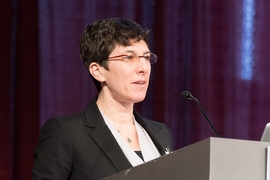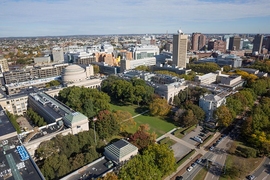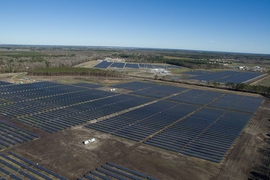MIT faculty, staff, and students came together to celebrate the progress of the Institute’s campus sustainability efforts and to put their heads together to brainstorm ways MIT's unique culture of innovation can be further leveraged to test new ideas.
The diverse group gathered on May 8 for Sustainability Connect 2017, the third iteration of the annual conference sponsored by MIT’s Office of Sustainability (MITOS).
Over the past several years, MIT has used its power both as a research institution and living lab to tackle the issue of global climate change. In October 2015, MIT released a five-year Plan for Action on Climate Change, setting goals like reducing campus emissions by at least 32 percent by 2030. In November 2015, the MIT Campus Sustainability Working Groups released their collective recommendations for advancing sustainable design and construction, materials management, and green labs across campus.
“Two years ago, when we launched this event, we challenged ourselves to determine how MIT can be a game-changing force for sustainability in the 21st century,” MITOS director Julie Newman said in her opening remarks. “And I’m pleased to report that in this short period of time we’re at a place where we can point to the transformative efforts that MIT has made.”
It has been a busy year for sustainability at MIT. Newman noted several recent developments including Access MIT, a commuter benefits program for employees to encourage the use of public transportation; Summit Farms, MIT’s landmark solar energy power-purchase agreement with area partners; and the launch of Energize MIT, a digital platform through which MIT faculty, students, and staff can access data about campus energy use.
Deputy Executive Vice President Tony Sharon invited the audience to see new opportunities arising from the work already being done in sustainability and to maintain the momentum.
“We can reinvent the ways we build our buildings and shape our open spaces, rethink the ways we provide energy to the campus, and with the new data analytics in place, we have many opportunities for analysis, critique, and learning,” Sharon said.
Seeking new opportunities was a major focus of Sustainability Connect 2017. It was reflected in the conference’s theme: “Cultivating the Test Bed: Harvesting a Better Future for All,” and through the day’s agenda of panels, presentations, and brainstorming sessions. Opportunities for innovative thinking explored incorporating social justice in future solutions, new intersections of innovation and campus sustainability, and new venues for faculty, students, and staff to use the campus as a living lab.
Keynote speaker Julian Agyeman, a professor of Urban and Environmental Policy and Planning at Tufts University, challenged the audience to incorporate social dimensions into their sustainability projects.
“It is very difficult to retrofit systems with equity and social justice once they are in place,” Agyeman said. “We need to think about these dimensions from the outset.”
Agyeman highlighted the unique opportunity of the MIT community to bring sustainable solutions to bear on cities with diverse populations like Boston and Cambridge, and called on the audience to prioritize both social justice and sustainability in their work.
The morning sessions served as a conversation forum for students, staff, and faculty directly involved with the task forces, committees, working groups, and research on sustainability at MIT.
The opening panel — “Exploring the Intersections between Innovation and Campus Sustainability at MIT” — touched on Institute’s history of innovation and current steps being taken by the administration to use this foundation for the next generation of sustainability projects.
Panelist Jim May, a senior project manager in MIT Campus Planning, explained how MIT’s architecture and campus spaces have always been ahead of their time and have served as a blueprint for university campuses around the world.
“We know that our research, science, and innovation are reflected in our architecture, and that our campus embodies what it is we want to do,” May said.
He said MIT has been rehearsing for the next paradigm shift in sustainable buildings, and is ready to again lead university campuses in taking the next steps.
Following the panel, participants conducted a workshop to explore what kinds of sustainability goals MIT might set in the future, on topics ranging from resilient buildings to smarter food systems.
“We are looking forward to working with campus leaders and the MIT community in the coming years to frame and define what goals will enable MIT to be a leader and exemplar of campus sustainability,” Newman said.
MITOS opened the afternoon sessions of Sustainability Connect to the greater MIT community this year, inviting students, staff and faculty from across departments to join the conversation on transforming the campus into a test bed and living lab for sustainability.
“This is the ‘muddy boots’ portion of the day,” said Joe Higgins, director of infrastructure business operations in the Department of Facilities.
Higgins moderated the afternoon panel: “Cultivating the Test Bed: Constructing the Campus Lab,” which featured the work of four researchers testing out sustainability solutions on campus.
“We’ve got a lot of ladder-climbers, hands-on wrench-turners, chemical-mixing folks here,” Higgins said “And the campus as test bed is a linking of these researchers with the operations staff at MIT.”
Panelists included Rachel Perlman, a PhD student in Institute for Data, Systems, and Society and MITOS Fellow who spoke about MIT’s material flow, and Kripa Varanasi, an associate professor in the Department of Mechanical Engineering, who discussed water savings in cooling towers located at MIT’s Central Utilities Plant. Other panelists were Marius Peters, a research scientist in the MIT Photovoltaics Research Lab who spoke about testing solar cells on campus, and Pamela Greenley, an associate director of MIT’s Office of Environment, Health and Safety who explored efforts to develop a green certification process for campus labs.
The day’s final ideation workshop was facilitated by MITOS staff and Amanda Graham of the Environmental Solutions Initiative. Audience members worked together in small groups to match campus-based questions with opportunities for partnerships, experiential learning and new research.
“We know that every person who works, visits or studies at MIT, regardless of their role, might have a big idea to improve the sustainability of the campus,” said Paul J. Wolff III, living lab design and strategic engagement project manager at MITOS. “We want to capture these ideas – and where possible, connect them with the right partners, infuse them with robust research and test them right here on the MIT campus in an effort to maximize the outcomes.”
The interactive activities illustrated what makes living-lab-style sustainability research unique at MIT. They also provided participants with a roadmap for cultivating new ideas and strategic collaborations moving forward.














